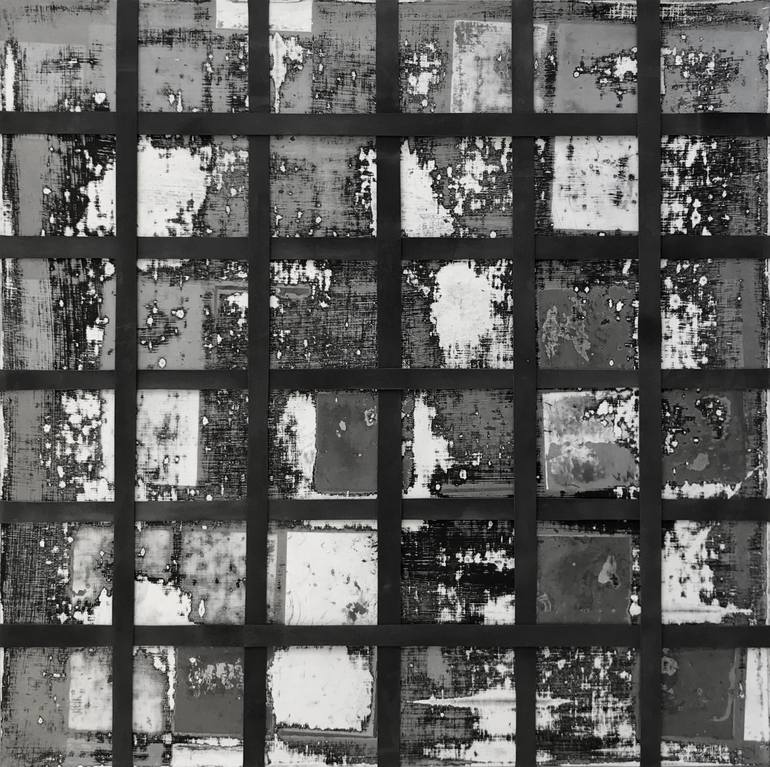






VIEW IN MY ROOM
91 Squares Painting
United Kingdom
Painting, Acrylic on Canvas
Size: 25.6 W x 25.6 H x 1.6 D in
Ships in a Box
Shipping included
14-day satisfaction guarantee
Artist Recognition

Artist featured in a collection
About The Artwork
The main themes in this work were the legacy of the grid, repetition, and the tension between chance and control. The question asked was: ‘At what point does the painter surrender control to chance occurrences and surprises and how much does the painter then intervene… if at all?’ The controls in this painting were the dimensions and materiality of the surface, the choice of paint, mediums and method of application. Chance determined outcome with no subsequent intervention to make corrections. A grid of rubber was then layered over the underlying painted grid.
Details & Dimensions
Painting:Acrylic on Canvas
Original:One-of-a-kind Artwork
Size:25.6 W x 25.6 H x 1.6 D in
Frame:Not Framed
Ready to Hang:Not applicable
Packaging:Ships in a Box
Shipping & Returns
Delivery Time:Typically 5-7 business days for domestic shipments, 10-14 business days for international shipments.
Handling:Ships in a box. Artists are responsible for packaging and adhering to Saatchi Art’s packaging guidelines.
Ships From:United Kingdom.
Customs:Shipments from United Kingdom may experience delays due to country's regulations for exporting valuable artworks.
Have additional questions?
Please visit our help section or contact us.
United Kingdom
Andrew Hardy is a painter who grew up in Derbyshire and now lives and works in London. Following a long career as a creative director in the retail design industry, working for many of Europe’s leading retailers and retail branding agencies, he now devotes himself full-time to painting. In 2019 he graduated from Camberwell College of Arts, part of the University of the Arts, London, with a BA (Hons) Painting (1st Class). During 2019-20 he had a studio at Turps Art School, London which provides an alternative educational environment at master's degree level for postgraduate painters. His association with Turps Art School continues. Hardy paints in an abstract language, using abstraction to work through broader questions of materiality, repetition, gesture and chance. When painting, he is occupied with the physicality of the process, connecting with his materials, tools and surfaces in different ways. The process is a form of performance. It is about the act of painting and he sees each finished work as a record of the journey he has been on with it, a record of an experiment or of a line of enquiry. The question of content is not in the foreground. The emphasis is on 'painting as object' rather than any recognisable image or narrative. Most of his work refers only to itself, to nothing but its own making. The emphasis is on form, materials and processes. The paintings are their own subject matter. The artist says of his paintings, "I don’t feel any urge to depict things or tell stories or make statements. I do not feel a need to paint scenes, situations or likenesses of people, or to be in any way referential whether literal, stylised, imagined or metaphorical. I seek to make work that is able to draw viewers in, to question and enjoy its materiality and facture. The work does not have any meaning although I do want it to be meaningful… which is a different thing.”
Artist Recognition

Artist featured by Saatchi Art in a collection
Thousands Of Five-Star Reviews
We deliver world-class customer service to all of our art buyers.
Global Selection
Explore an unparalleled artwork selection by artists from around the world.
Satisfaction Guaranteed
Our 14-day satisfaction guarantee allows you to buy with confidence.
Support An Artist With Every Purchase
We pay our artists more on every sale than other galleries.
Need More Help?